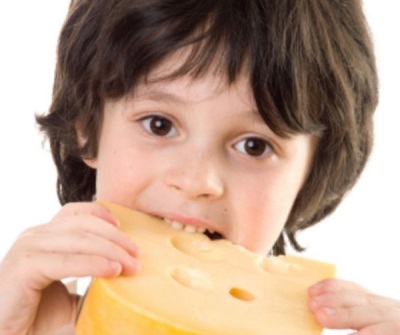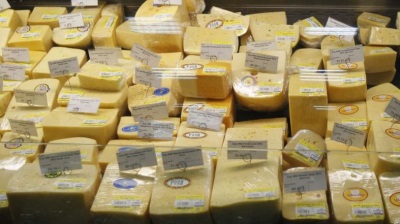From what age can you give cheese to children?
Cheese is a favorite product for many adults, so with the beginning of the introduction of complementary foods to a child under one year, most mothers wonder if they can give it to their son or daughter at an early age and which product to choose from a huge range for baby food.
What is useful
Cheese belongs to the tasty products, from the correct use of which will only benefit:
- It acts as a source of proteins, from which kids get the whole range of amino acids that are important for their body.
- Rich in calcium and contains it several times more than cottage cheese and other dairy products.
- Among the vitamin composition is especially many vitamins E, D, groups B, A and PP.
- In addition to calcium, the product contains phosphorus, potassium, sodium, zinc, iron, sulfur and many other mineral salts.
- Fatty acids have a positive effect on the skin, brain function and internal organs.
- Nutrients are well absorbed in the body, helping the child grow and develop normally.
- Inclusion in the children's menu helps to expand the taste palette and diversify dishes for kids.
- Since cheese is a hard product, chewing it will stimulate the development of the child’s jaw apparatus.
- Helps to quickly cope with hunger and gives energy. It is recommended for children with a shortage of body weight.
Hard cheese can be given to children with lactose intolerance, because during its manufacture lactose leaves the whey, and its residues are destroyed by bacteria while the product matures.
disadvantages
- Since cheese belongs to high-protein products, its use is not recommended for kidney disease.
- They should not be included in the diet of children with diseases of the digestive tract. They can cause constipation.
- It is a source of cholesterol and saturated fatty acids, so its significant presence in the human diet contributes to metabolic disorders and cardiovascular diseases.
- Excess salt in cheese can provoke fluid retention after it is consumed, and also has a negative effect on kidney function.
- Some children have an allergy that can manifest itself. indigestion, skin rashes, an asthma attack, skin itching, nausea, fever and other symptoms. Children under one year old are at high risk of an allergic reaction; therefore, it is best to offer cheese to a one-year-old child, and if the crumbs have a tendency to be allergic, then familiarity with this product should be postponed for a later period. With age, the intestinal walls become more resistant to the penetration of allergens, and the child’s immunity is strengthened, which reduces the risk of allergies.
- If you exceed the recommended daily portion, obesity may develop. Due to the high caloric content such dairy products give in small quantities.
- High fat content in many children provokes nausea, liquefaction of the stool or intestinal colic. Such symptoms may appear after eating fatty cheese, even in small quantities.

When eating cheese, you need to know a lot of nuances, the most important of which you will learn by watching the “Live Healthy” program.
How many months can I give?
Despite the many beneficial qualities Most pediatricians do not recommend the inclusion of cheeses in the diet of children up to 10-12 months. This is due to the high content of protein and minerals with which the kidneys of babies of the first year cope with difficulty. For this reason, you should not give a product to a 6-9 month old baby. The first piece is to offer the baby not earlier than 10 months, and better - from 1 year.
Kinds
The range of cheeses in our stores is quite extensive, but many of them are unacceptable to give children the first years of life.
First of all, cheese is not suitable for baby food:
- With mold. Its use threatens the child with allergies or poisoning, as well as such a dangerous infectious disease as listeriosis. And because these varieties are not advised to give children at least until the age of 7, and some doctors recommend to postpone familiarity with such soft cheeses to 12 years.
- Smoked. His method of manufacture makes it harmful for children and deprives of many useful substances. Include it in the diet of children can be no earlier than 6-7 years.
- Too sharp. He is able to adversely affect the digestive tract of the child.
- Fused Neither cheese in foil, nor creamy processed cheeses are suitable for feeding the children, because they are very salty and too fat. In addition, they are made from waste, and therefore are not recommended for children or adults.
- Brine, for example, feta cheese, Adyghe, feta or suluguni. In the production process, these varieties of cheese are kept in brine, as a result of which the product acquires a salty taste. However, excess salt is harmful to a small child, so they are not suitable for the children's menu.
- With different additivesFor example, with nuts or pepper.
- Cheese product. To reduce the cost, they add components harmful to children, so they cannot be labeled as “cheese” on the label. Giving such products to children is undesirable.
You should also not feed the children with the usual fatty cheeses for adults, for example, varieties Edam, Gouda or Russian. Their fat content exceeds 45-50%, which makes them unsuitable for the diet of children who are not yet 1 year old.
The most preferred fat content of cheese for a child is considered up to 30-35%. Give the kids semi-hard and hard cheese. Among products with a minimum of salt, children are recommended Cheddar, Altermani, Maasdam, Mozzarella or Ricotta.
The best option for feeding a child is called special products intended for children (with a corresponding mark). This cheese has a low fat content and reduced salt content.
How to choose
Buying cheese for baby food, pay attention to its composition and freshness. The product should not be flavors, dyes, emulsifiers, flavor enhancers and other additives. Always check the expiration date, smell the product and be sure to try it to taste.
Do not save on the product that will be eaten by a child, because cheap cheese often has low quality, can be immature or spoiled. Inspect also the packaging - for children products that are placed in polystyrene (PS) are undesirable, therefore it is better to buy the product in polypropylene packaging (PP).
How to put in a lure
If your child is already 10-11 months old, you can introduce him to cheese by offering a tiny piece of such a product. Give hard cheese in the morning feeding and watch the reaction to the new baby dish during the day. If such a test has not caused any health problems, you can include it in the diet of the crumbs on an ongoing basis.
If the piece of cheese you are going to give your child is quite salty, it should be placed in clean water for 2-3 hours. During this time, change the water several times, filling the cheese with clean cold water.After that, the product can be offered crumbs. Although its taste will change and the product will be more bland, but it will not bring harm to the child’s body.
How much to give?
- A child under one year old needs a small amount of cheese 2-3 times a week. Let each portion be no larger than a pea. In the year the daily amount is 5 grams, but to give such a product every day is still not worth it. Just two or three cheese days a week are enough.
- When the child is 1.5 years old, the daily portion can be increased to 10-15 g, and from the age of two you can be given about 20 g per day. such a product. Hard cheese for a child of the first years of life is recommended to be given in a rubbed form. It can be rubbed into vegetable dishes or omelets, as well as added to casseroles.
Well combined cheeses and fruits, without interfering with the digestion of each other. But the combination of cheese with meat or butter in one dish for children up to three years is undesirable, because all these products contain a lot of fats and proteins, which increases the load on the children's body. From 3 years old, cheeses can be given to a child separately - slices and on sandwiches.
Many children over 3 years old enjoy the combination of cheese with bread, but if a child refuses sandwiches, you do not need to insist. Tastes gradually change, and at school age he will surely fall in love with this type of snack. It is convenient to take it for a walk or to give the child with you to school.
DIY cheese
If desired, you can make cheese at home. It will remotely resemble traditional hard cheese, but mom can be sure of the quality of the product.
The recipe for homemade cheese is:
- Put 700 g of cottage cheese in a saucepan and mash, then pour with a liter of milk.
- Place the container on the fire and stir constantly until the whey separates and the formation of a thick mass.
- Throw the curd mass on the gauze and let drain the liquid.
- In a saucepan, combine 2 tbsp. spoons of butter, 2 chicken eggs, a teaspoon of soda and 2 tsp of salt.
- Mix everything and add pressed cottage cheese.
- Actively knead the ingredients until a smooth mass is formed, in which there will be no white grains.
- Put the cheese in the mold and place in the refrigerator so that it stiffens.
See the following videos for home cooking.




































































